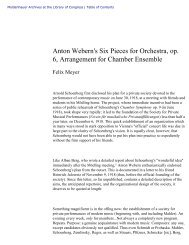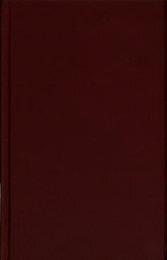Country Profile: Cuba - American Memory - Library of Congress
Country Profile: Cuba - American Memory - Library of Congress
Country Profile: Cuba - American Memory - Library of Congress
You also want an ePaper? Increase the reach of your titles
YUMPU automatically turns print PDFs into web optimized ePapers that Google loves.
<strong>Library</strong> <strong>of</strong> <strong>Congress</strong> – Federal Research Division <strong>Country</strong> <strong>Pr<strong>of</strong>ile</strong>: <strong>Cuba</strong>, September 2006<br />
Granma, the <strong>of</strong>ficial communist party newspaper, published photos <strong>of</strong> Castro being visited in his<br />
hospital room on his birthday by his brother and President Chávez. Despite Castro’s apparent<br />
improvement, in late September there was no indication that he would be resuming the full roster<br />
<strong>of</strong> his previous powers anytime soon, if at all. The temporary transfer <strong>of</strong> power, described by<br />
some observers as a dress rehearsal for a post-Castro transition, appeared more likely to become<br />
the actual succession. Nor was there any clear evidence that the leadership transition would<br />
evolve toward democratization, despite the assertion <strong>of</strong> opposition leader Osvaldo José Payá<br />
Sadinas that fidelismo would not survive Fidel and that Raúl Castro’s assumption <strong>of</strong> power<br />
would mean the country had entered a stage <strong>of</strong> substantial democratic opening. In the shorter<br />
term, according to some outside experts, a likely scenario is for Raúl Castro to serve as a<br />
pragmatic but low-pr<strong>of</strong>ile chairman <strong>of</strong> a collective leadership until elections are held for the<br />
Council <strong>of</strong> State president and first secretary <strong>of</strong> the PCC.<br />
Likely key leaders include the aforementioned younger-generation leaders, but particularly Lage<br />
Dávila and Pérez Roque, along with National Assembly President Ricardo Alarcón de Quesada,<br />
who is <strong>Cuba</strong>’s most experienced diplomat. Although Raúl Castro apparently retains strong<br />
support within the FAR for his competent management <strong>of</strong> one <strong>of</strong> <strong>Cuba</strong>’s strongest institutions as<br />
well as for his successful command <strong>of</strong> the FAR during three overseas wars, his leadership <strong>of</strong> a<br />
post–Fidel Castro administration would itself likely be transitional because <strong>of</strong> his age—he turned<br />
75 on June 3, 2006, reportedly poor health, and lack <strong>of</strong> his brother’s charisma and national and<br />
international stature. Interior Minister and Army Corps General Abelardo Colomé Ibarra, who is<br />
next in the hierarchy <strong>of</strong> power after Raúl Castro, would be another likely transitional candidate;<br />
as a revolutionary comrade <strong>of</strong> the Castro brothers, Colomé would likely advocate a continued<br />
strong military role in government.<br />
Executive Branch: The 31-member Council <strong>of</strong> State, whose members and president are elected<br />
by the National Assembly <strong>of</strong> Popular Power to serve as the Assembly’s permanent organ, is, in<br />
effect, the highest decision-making representative <strong>of</strong> the state because the National Assembly<br />
meets only twice a year for a few days each time. The president <strong>of</strong> the Council <strong>of</strong> State is also<br />
president <strong>of</strong> the Council <strong>of</strong> Ministers, in which executive and administrative authority is vested,<br />
and thus serves as both chief <strong>of</strong> state and head <strong>of</strong> government. In mid-2006, the Council <strong>of</strong><br />
Ministers had 28 ministry posts (two <strong>of</strong> which were vacant), including the minister without<br />
portfolio. The constitution empowers the Council <strong>of</strong> Ministers, as the highest executive and<br />
administrative organ, to issue regulations to administer laws and decrees and to authorize<br />
exceptions to state ownership <strong>of</strong> the means <strong>of</strong> production. The ministers are responsible<br />
principally to the Council’s nine-member Executive Committee, which includes its president,<br />
first vice president, and five other vice presidents. The Executive Committee is the decisionmaking<br />
body <strong>of</strong> the Council <strong>of</strong> Ministers, and one <strong>of</strong> its main functions is to oversee the<br />
administration <strong>of</strong> the economy. The Council <strong>of</strong> Ministers answers to the National Assembly and<br />
to the Council <strong>of</strong> State. The president and vice presidents <strong>of</strong> the Council <strong>of</strong> State and the<br />
National Assembly elect ministers for a term <strong>of</strong> five years. Elections were last held in March<br />
2003 and are next scheduled for 2008.<br />
The 24-member Political Bureau <strong>of</strong> the Central Committee <strong>of</strong> the Communist Party <strong>of</strong> <strong>Cuba</strong><br />
(Partido Comunista de <strong>Cuba</strong>—PCC) is the party’s leading decision-making institution and<br />
<strong>Cuba</strong>’s most important decision-making entity. The PCC monopolizes all government positions,<br />
23



![Albert Einstein Papers [finding aid]. Library of Congress. [PDF ...](https://img.yumpu.com/21604228/1/190x245/albert-einstein-papers-finding-aid-library-of-congress-pdf-.jpg?quality=85)





![American Colony in Jerusalem Collection [finding aid]. Library of ...](https://img.yumpu.com/17941275/1/190x245/american-colony-in-jerusalem-collection-finding-aid-library-of-.jpg?quality=85)



![Piccard Family Papers [finding aid]. - American Memory - Library of ...](https://img.yumpu.com/17941234/1/190x245/piccard-family-papers-finding-aid-american-memory-library-of-.jpg?quality=85)


